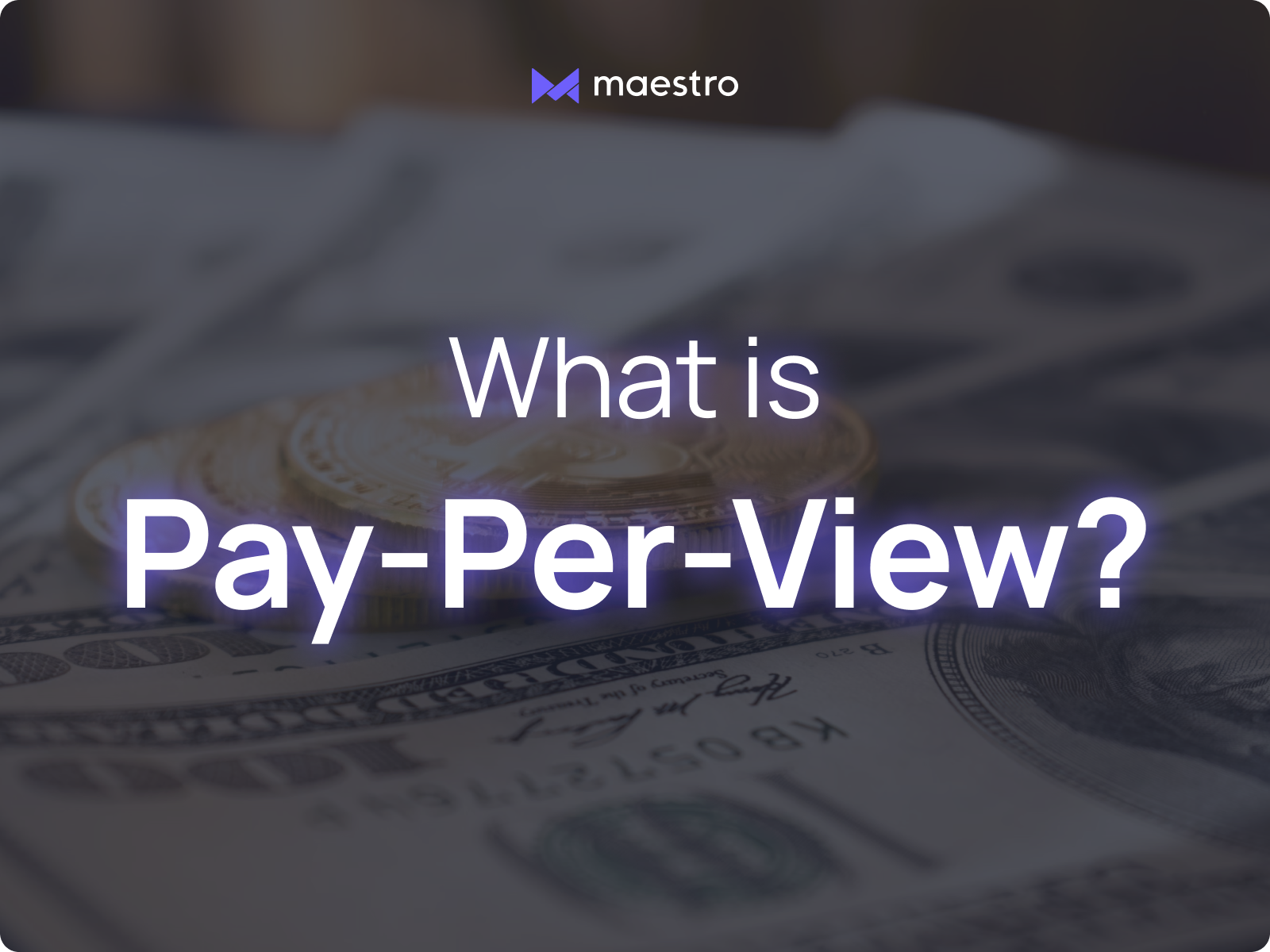What is Pay-Per-View (PPV)?: Your Guide to Pay-Per-View Streaming

Pay-per-view streaming has been a popular monetization model since the early days of on-demand video consumption. This predates the online video streaming model we know today and dates back to the pay-per-view options offered by satellite and cable providers.
Thanks to the rise of OTT streaming, pay-per-view is popular once again since it allows businesses of any size to sell access to their video content.
In this article, we’re going to discuss all things pay-per-view streaming. We will cover what pay-per-view streaming is and how you can create a pay-per-view website of your own. To wrap things up, we will quickly review a couple of alternatives to pay-per-view.
Table of Contents
- What is Pay-Per-View Streaming?
- How to Create a Pay-Per-View Website
- Alternative Monetization Options
- Pay-Per-View Streaming on Maestro
What is Pay-Per-View Streaming?

Pay-per-view (PPV) streaming is a type of video monetization that requires users to purchase access to each piece of content they watch. This type of monetization technique is also known as transactional video on demand, or “TVOD” for short.
When it comes to series and films, pay-per-view is comparable to renting or buying a movie at Blockbuster. In the live event space, pay-per-view can be likened to ticketing, where users make a one-time purchase to access a virtual event.
Prime Video is an excellent example of a streaming service that uses pay-per-view streaming. Pay-per-view is also commonly used to monetize MMA fights with famous boxers.
It’s important to note that this monetization model is different from subscription-based video monetization, which was made popular by Netflix, but we will dive into that later in this article.
Benefits of Pay-Per-View Streaming
Pay-per-view streaming has several benefits for both video publishers and their viewers.
The main benefit for viewers is that it allows them to pay for exactly what they want. For example, if there is only one title they want to watch on a platform, they can pay for just that instead of subscribing to the service for a higher fee.
Another benefit to viewers is that PPV streaming doesn’t usually have ads, so the viewing experience is better.
This monetization model is also great for brands, creators, and publishers that have a small library of premium content to sell. When you create a video subscription service, there is more pressure to grow your content library or host a series of live events, but with PPV, it’s okay if you only have a handful of titles or events to share.
How Does PPV Streaming Work?
Pay-per-view streaming is very straightforward. Viewers choose a title they’d like to watch and pay a one-time fee for access. How long this access lasts depends on how the publisher sets it up.
For example, some pay-per-view streaming sites make videos available for rent, whereas others grant lifetime access with purchase. Some services, like Prime Video, give viewers a choice between renting and buying for different prices.
How to Create a Pay-Per-View Website
Thanks to the evolution of streaming technology, the pay-per-view monetization model is accessible to businesses of any size. Even with limited technical experience, a video publisher can create a functional pay-per-view website of their own.
With that said, let’s review five steps that you can follow to create a pay-per-view website for your premium content.
1. Choose a Platform
Creating a pay-per-view website requires the support of an online video platform (OVP). However, not just any OVP will do. You’ll need one that offers dedicated PPV or ticketing support.
In addition to PPV or ticketing, it is important that your chosen platform supports the other video hosting tools you need to reach your streaming goals. This could include brand customization, live streaming, on-demand streaming, video analytics, community management, and more.
Some popular online video platforms with pay-per-view support include Maestro, Castr.io, Muvi, and Kaltura. We recommend taking advantage of demos and free trials to find the OVP that best suits your needs.
2. Build Your Site
Next, it is time to build your pay-per-view site. This step looks a little bit different depending on the online video platform you choose.
Some OVPs, such as Maestro, include a drag-and-drop video website builder that makes it easy to create a site to host your video content. If this is the route you take, you can design and launch your site in a matter of hours or days, and you can save a ton of money by taking this DIY approach.
Another option is to have your site built by a professional designer and then embed your video player from your online video platform. This approach is a bit more costly, and the timeline tends to be quite a bit longer. The benefit of taking this route is that it allows for greater customization of your site and the viewer experience.
3. Prepare Your Content

Once your site is built, you should prepare your content. If you’re creating on-demand experiences, you’ll upload and organize your titles. If your online video platform allows you to edit metadata, we recommend adding descriptions and tags so that your titles are easy to access and your site is easy to navigate.
For live events, you’ll schedule the stream on the platform. At this stage, you might even connect your sources and streaming tools depending on how close you are to launch. Check out our virtual event production guide to learn a bit more about this step.
This process will vary depending on the OVP you’re using, so refer to your chosen platform’s documentation for the specifics.
4. Set Up Monetization
After you’ve uploaded your on-demand videos or scheduled your streams, you’ll configure your monetization setup. By this stage, you should have pricing figured out so that you can plug that information into your online video platform.
How you price your pay-per-view videos will entirely depend on the type of content you’re offering and what sort of audience you’re targeting. For example, a ticket to a virtual concert may cost $25 to $50, whereas renting a movie for 48 hours could cost closer to $1 to $2.
If you don't know where to begin pricing your content, checking out your competitors’ pricing is a good place to start.
5. Launch Your Pay-Per-View Website
After your site is set up and your content is prepared, it’s time to launch your PPV website. Just like any business, marketing is key to getting your site in front of your target audience.
We recommend exploring some digital marketing techniques, including social media marketing, influencer marketing, paid ads, email marketing, brand collaborations, and SEO. Test out different options to see what your audience responds to best.
Alternative Monetization Options

While we’re on the topic of pay-per-view streaming, let’s take a moment to review a couple of popular monetization methods that can be used as alternatives to PPV.
Subscriptions
As we discussed, subscription-based video monetization is very popular in the online streaming space. With subscriptions, viewers pay a flat fee for unlimited access to a collection of content. Streaming subscriptions are typically paid monthly, but they can also be billed annually or quarterly.
Some streaming services use a combination of subscriptions and PPV. We mentioned Prime Video as one of the most popular pay-per-view sites, but the platform actually uses a subscription/PPV combination. With this setup, some titles are available with a subscription, and others need to be purchased individually.
Ads and Sponsors
Advertisements and sponsorship are another great way to monetize content without requiring viewers to pay for it. In this monetization model, brands pay for access to your audience.
The obvious pro to this monetization model is that getting viewers is easier since there is no fee for viewers. The downside is that sometimes advertisements can be bothersome to viewers.
Typically, pay-per-view is not combined with advertisements since users pay for access to the titles they want to watch.
Pay-Per-View Streaming on Maestro

Are you ready to create a pay-per-view website of your own? Maestro has all of the tools you need to build this type of video business.
In addition to ticketing and other flexible monetization tools, Maestro includes video website building, white-label streaming, comprehensive analytics, a community dashboard, and more.
Sign up for Maestro to start building your pay-per-view website in no time at all.